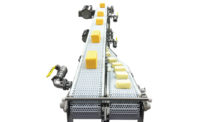Recapture the energy from cranes and conveyors in dairy plants
Cranes and conveyors do more than move cartons and pallets of dairy products. They are sources of electrical energy that can be captured and redeployed in a dairy processing plant.

The Premier Tech Chronos RPK series robotic case packer has a “scalable” design ranging from a single robot to multiple robots (dual, quad, or 2 x dual modules) to suit production throughputs and package pattern requirements.

American-Newlong’s EC-201 robotic palletizer features a payload capacity of 440 pounds and a palletizing capacity of 1,600 cycles per hour. It palletizes bags, cases, pails and other products.


Cups of yogurt travel down conveyors toward tray packagers or cartoners to be stacked on pallets and stored in a refrigerated warehouse. All of these steps serve to protect the product. This package-handling machinery is also a source of energy that dairy processors can recover and redeploy elsewhere in the plant.
Conveyors contribute energy from friction when braking on downward vertical motion. Recuperating this energy can account for about 3% from conveyor lifts and 7% to 10% from ASRS cranes, mini-load cranes and shuttle systems, according to Markus Schmidt, president of Swisslog Warehouse & Distribution Solutions, Americas. The recuperated energy, when shared, can reduce the energy draw significantly.
With ASRS cranes, the recuperated energy is generated from the vertical-axis downward motion of the crane’s carriage. This can be redirected or shared to offset the comparatively heavier energy draw from the concurrent horizontal-axis motion of the crane. When this happens, the energy draw can be reduced by up to 20%, according to Swisslog.
Slow down the conveyor
Another energy-saving action that dairy plant managers can take is to slow down the speed of a conveyor. When there are variable-speed drives on conveyors, “significant” energy savings can be realized during low-throughput periods in plants using thousands of feet of powered conveyors, Schmidt said.
“In automated conveying systems, the greatest amount of energy is consumed while the conveyor is running, not during initial acceleration,” said Samuel Schaerer, the controls development manager at Swisslog’s technology center in Switzerland. “Control systems that permit conveyor sections to be automatically turned on and off depending on whether throughput is occurring or not are inherently more energy-efficient.”
Packing and stacking small items
Besides providing energy, equipment can be used to ensure efficient packaging. No dairy processor wants to ship a carton of air. But that is exactly what one European dairy was doing. The maker of individually portioned coffee creamers was simply dumping the cups into a carton. The dairy processor knew it needed to be more efficient, but didn’t know how to get there.
Then the dairy plant’s head of operations met with an equipment supplier who suggested a robotic picker and palletizer. As a result, creamers are now stacked in layers in the cartons with no dead air spaces in between.
Gerhard Schubert, an equipment supplier based in Germany, recommended its TLM system, which consists of seven modules and is equipped with five F2 robots, an F4 robot and two Transmodul lines. Schubert did not want to name its dairy customer but it provided details of the installation.
For the dairy plant, it was important that the machine had an in-feed and out-feed station so that capsules could be removed (and later reintroduced) from the entire system for quality-control purposes.
Overall, the system processes 15 different carton sizes with 60, 120, 240, 320 or 360 packs per carton and with portion packs capacities of five to 15 grams (about half an ounce). Depending on the content, the system can process between five and 28 cartons per minute, with a constant output of 1,600 portion packs per minute.
The dairy processor has reduced packaging material requirements by 17%. This, in turn, means that the company has reduced its storage space by one-third.
Upgrading warehouse software
Almost 20 years after opening a warehouse, Hershey Creamery Co. needed to upgrade the building’s IT infrastructure. Hershey operates a 10,000 pallet position, eight-storage-level warehouse in Middletown, Pa. The two-aisle system has a combination of five- and seven-deep storage lanes. Each aisle contains one storage and retrieval machine (S/RM) capable of handling approximately 70 pallets per hour.
Westfalia, which designed the original warehouse in 1997, upgraded the facility’s legacy WMS to the latest version of the Savanna.NET Warehouse Execution System (WES). The WES combines a tightly integrated WMS and warehouse control system into a single application. The software simplifies and controls the entire warehousing process, while reducing the complexity of using several different function-specific applications. In addition, Westfalia replaced Hershey’s old wireless communications system with optical data couplers.
As a result, Hershey can more efficiently utilize warehouse space and equipment, increase order accuracy, improve customer service, reduce the risk of lost or damaged product, and raise throughput and productivity.
Other uses for palletizers
Palletizers are commonly found at the end of a processing line. But they play roles throughout a dairy plant. For example, Multi-Conveyor built a de-palletizer that unloads skids of empty containers in bulk onto a single filer to prepare the containers for filling. This is a double-decker system that can be run by a single operator, said Cheryl Miller, the company’s director of marketing.
Palletizers and depalletizers can be used in a variety of ways, said Doug Stoll, a product manager for Intelligrated. He said traditional palletizing systems consist of a dedicated production line(s) feeding a palletizer(s). A multi-line palletizer differs in that “waves” or “batches” can be accumulated or processed in a separate buffer location prior to being palletized.
“Technically, the palletizer is end-of-line, however, the palletizer in this case is uncoupled from a single production line,” he said.
Pros and cons of unitized loads
Pallet loads don’t have to be built on a pallet. These so-called “unitized loads” are essentially built on conveyor beds and/or a slip sheet, Stoll said. Unitizing creates a need for special conveyor and equipment. Such systems require planning from front to back for conveyor style and control as well as lift truck capabilities.
A one key advantage is that the cost and handling of pallets goes away. In addition, this method provides a level of convenience, he added.
In many cases, unitized loads are clamped with a lift truck and placed into racks or onto the proper pallet type for that load. An important disadvantage of this approach is the potential for product damage, Stoll said. The weight and type of packaging can also present unit load handling challenges for lift trucks or conveyors.
If a dairy needs to add a line, older plants can pose challenges to building designers who are trying to figure out how and where to install the equipment. Miller said one solution is to build a secondary high-rise system that hovers over existing lines. Another approach is to install lift-gate mechanisms so an operator can move through an existing line by elevating a section in order to walk through it. There are also portable low-profile transfer conveyor systems which are convenient sanitary solutions for tight areas or quick inline transfers.
Equipment such as spirals, vertical lifts and inclines all help with footprint constraints, Stoll said. If available, using vertical space is the best option in many cases when floor space is limited and/or improved safety and work flows are desired.
Hanging conveyors allows for additional equipment, like accumulation, to be installed, if the building structure can accommodate the hanging conveyor and live loads, he said. While this can be cost-effective, plant managers must consider potential accessibility concerns like jams and maintenance.
Robots and conveyors offer other benefits, including making the workplace safer and deploying employees to perform higher-value tasks. And, as discussed above, these pieces of machinery are energy sources. Be sure to tap into their full potential.
Looking for a reprint of this article?
From high-res PDFs to custom plaques, order your copy today!









